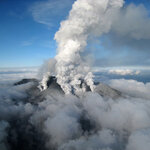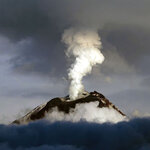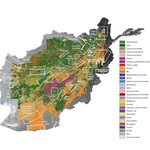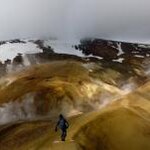Geology

Hydraulic fracturing, commonly called fracking, is a way to extract natural gas from shale rock, by using a modern process to inject a high-pressure water mixture at the rock to release the gas inside. By all accounts it has been an environmental boon, responsible for causing energy emissions from coal to plummet back to early 1980s levels without causing energy prices to rise and harm poor people.
But two employees of a software development company and a Department of the Interior member say fracking is causing earthquakes, they just weren't felt by the public. Micro-earthquakes are…

Four urban sections of the San Andreas Fault system in Northern California have stored enough energy to produce major earthquakes, according to a new study of 'fault creep', and three fault sections, near Hayward, Rodgers Creek and Green Valley, are nearing or past their average recurrence interval.
The earthquake cycle reflects the accumulation of strain on a fault, its release as slip, and its re-accumulation and re-release. Fault creep is the slip and slow release of strain in the uppermost part of the Earth's crust that occurs on some faults between large earthquakes, when much…

Phreatic eruption: Mount Ontake. Credit: EPA/Ministry of Land, Infrastructure
By Rebecca Williams, University of Hull
Mount Ontake, Japan’s second-highest volcano, erupted killing at least 31 people on September 27.
Since then, there has been feverish speculation about why tourists were on an active volcano and why the eruption wasn’t predicted.
Mount Ontake (also known as Ontakesan) is a stratovolcano which last erupted in 1979-80 and 2007 (there was also a possible, unconfirmed eruption in 1991). Before this, there were no recorded historical eruptions at Mount Ontake.
Since the eruption…

Planetary geologists have speculated for decades that glaciers might once have crept through Valles Marineris, the 2,000-mile-long chasm that constitutes the Grand Canyon of Mars.
Using satellite images, astronomers have identified features they say might have been carved by past glaciers as they flowed through the canyons but those claims have remained highly controversial and contested.
Now, a joint team from Bryn Mawr College and the Freie Universitaet Berlin has identified what could be the first mineralogical evidence of past glaciers within the Valles Marineris: a layer of mixed…

Volcano season. Some think it's the time of the year. Credit: EPA
By Robin Wylie, University College London
The Earth seems to have been smoking a lot recently. Volcanoes are currently erupting in Iceland, Hawaii, Indonesia and Mexico. Others, in the Philippines and Papua New Guinea, erupted recently but seem to have calmed down. Many of these have threatened homes and forced evacuations. But among their less-endangered spectators, these eruptions may have raised a question: Is there such a thing as a season for volcanic eruptions?
Surprisingly, this may be a possibility. While volcanoes may…

Landslides on Mars typically have runout distances much larger than equivalent features on Earth, and therefore can interact with older landforms that are distal to the failure scarp.
Regardless of the exact formation mechanism of these landslides, it is evident that their combined large area and relatively well constrained formation age can be exploited to better understand the evolution of coincident features, particularly if those features have been modified since the landslide event.
Now the researchers from the University College London (UCL) describe interior layered deposits on the…

Credit: Image of map courtesy of the USGS and composite image by Patricia Waldron
By: Patricia Waldron, Inside Science
(Inside Science) -- People living in Afghanistan have mined precious gems from their land, such as lapis lazuli, since the times of the Egyptian pharaohs. But modern analyses of the country's mineral deposits show that the Afghan people have barely scratched the surface of their mineable wealth.
Maps created by the U.S Geological Survey reveal deposits of copper and iron ore as well as rare earth minerals, which are in demand for electronics manufacturing. If properly…

The 500 million years after Earth formed were not the hot, lava-filled Hell commonly portrayed, it may have had oceans, continents and active crustal plates - a lot like we have today.
This alternate view of Earth's first geologic eon, called the Hadean, gets support from the first detailed comparison of zircon crystals that formed more than 4 billion years ago with those formed contemporaneously in Iceland, which has been proposed as a possible geological analog for early Earth.
From the early 20th century up through the 1980's, geologists generally agreed that conditions during the Hadean…

A tiny fragment of Martian meteorite 1.3 billion years old contains a 'cell-like' structure, which investigators say once held water, according to findings published in Astrobiology.
While investigating the Martian meteorite, known as Nakhla, Dr. Elias Chatzitheodoridis of the National Technical University of Athens found an unusual feature embedded deep within the rock. In a bid to understand what it might be, he teamed up with long-time friend and collaborator Professor Ian Lyon at the University of Manchester.
Lyon explains, "In many ways it resembled a fossilized biological cell…

American cars didn't cause all climate change, no matter what you may have read. Around 13,000 years ago, a sudden, catastrophic event caused drastic climate change and much of the Earth was plunged into a period of cold climatic conditions and drought. This drastic climate change, now called the Younger Dryas, coincided with the extinction of Pleistocene megafauna, such as the saber-tooth cats and the mastodon, and resulted in major declines in prehistoric human populations, perhaps including the termination of the Clovis culture in America.
With such limited evidence, there has been nothing…